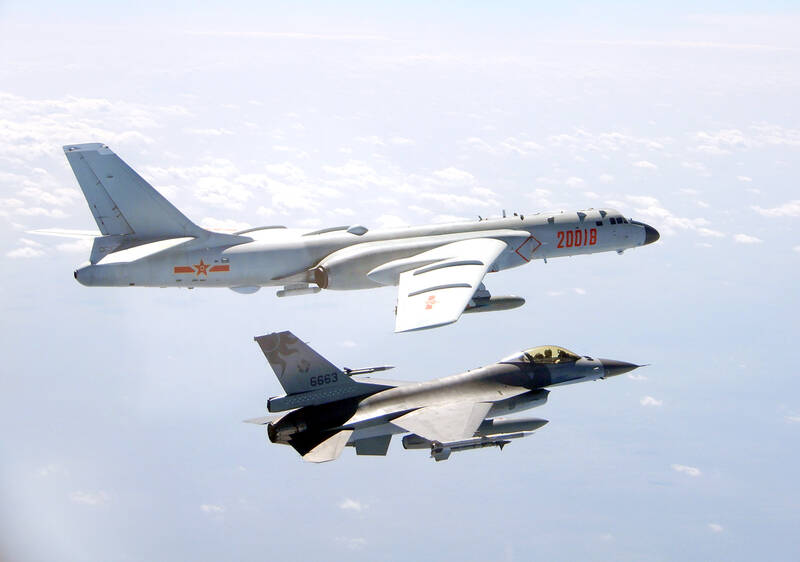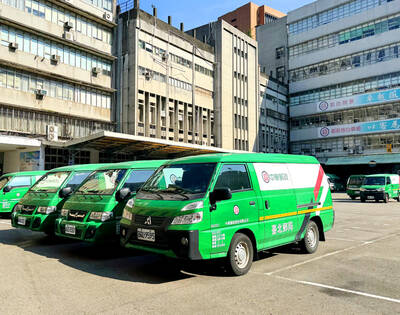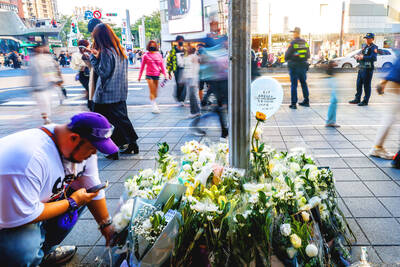China’s latest military exercises represent a new challenge to Taiwan’s legal authority to demarcate its borders in the Taiwan Strait, a defense expert said, adding that the fleets in the latest exercises were likely the most powerful the People’s Liberation Army (PLA) ever assembled.
The PLA conducted military exercises from Sunday last week to 6am on Friday, which encompassed large swathes of the western Pacific, including the Taiwan Strait and waters off the Philippines and Guam, National Policy Foundation associate research fellow Chieh Chung (揭仲) said on Friday.
The Ministry of National Defense said that it detected 70 warship and 162 aircraft sorties over the period in the Strait.

Photo courtesy of the Ministry of National Defense
China’s Northern, Southern, and Eastern Theater commands participated in the exercises, with each command deploying its fleet and a large complement of aircraft to different strategic axes in the Taiwan Strait and waters off the Philippines and Guam, he said.
These actions signified an escalation in China’s “gray zone” warfare against Taiwan and a show of force directed at the nation, Japan and the US simultaneously, Chieh said.
Chieh said that PLA aircraft not only crossed the median line of the Strait on the first day of the exercises, but also deliberately entered prohibited airspace zones designated R8, R9, R11 and R5, which were claimed by Taiwan, he said.
Two four-plane flights of Shenyang J-16 jets loitered in R9 and R11, the nearest of the intruded areas to Taiwan proper, he said.
The intrusions set a new benchmark for China’s “gray zone” tactics and possibly a new pattern that the PLA would attempt to normalize, he said.
Chinese military aircraft entering these areas had the effect of compressing the depth of Taiwanese air defenses and undermining the nation’s legal authority to establish a prohibited airspace, he said.
On Monday, a PLA Navy (PLAN) destroyer-frigate group of eight vessels and a carrier strike group centered on the carrier Shandong with five escort vessels transited the Miyako Strait and Bashi Channel respectively, Chieh said.
After three days, the Chinese navy again transited the Miyako Strait with the 45th Chinese Naval Escort Task Force, a group composed of three warships of the Northern Theater Command and designated for the Gulf of Aden, he said.
The PLAN deployed three major naval groupings that included 17 surface vessels and an unknown number of submarines, he said.
This force possessed the highest concentration of combat power ever amassed in the PLAN’s history and numerically the largest Chinese fleet exercise in the western Pacific since 2014, Chien said.
Information provided by the Japanese government further indicated that the fleets divided into two groups and engaged in a mock battle that started on Wednesday in an area including the Philippine Sea and waters off Guam, he said.
The simulated battle was a demonstration of China’s capabilities to conduct large-scale naval operations centering on a carrier strike group in the western Pacific targeting the US and other nations, Chien said.

SHIPS, TRAINS AND AUTOMOBILES: The ministry has announced changes to varied transportation industries taking effect soon, with a number of effects for passengers Beginning next month, the post office is canceling signature upon delivery and written inquiry services for international registered small packets in accordance with the new policy of the Universal Postal Union, the Ministry of Transportation and Communications said yesterday. The new policy does not apply to packets that are to be delivered to China, the ministry said. Senders of international registered small packets would receive a NT$10 rebate on postage if the packets are sent from Jan. 1 to March 31, it added. The ministry said that three other policies are also scheduled to take effect next month. International cruise ship operators

HORROR STORIES: One victim recounted not realizing they had been stabbed and seeing people bleeding, while another recalled breaking down in tears after fleeing A man on Friday died after he tried to fight the knife-wielding suspect who went on a stabbing spree near two of Taipei’s busiest metro stations, Taipei Mayor Chiang Wan-an (蔣萬安) said. The 57-year-old man, identified by his family name, Yu (余), encountered the suspect at Exit M7 of Taipei Main Station and immediately tried to stop him, but was fatally wounded and later died, Chiang said, calling the incident “heartbreaking.” Yu’s family would receive at least NT$5 million (US$158,584) in compensation through the Taipei Rapid Transit Corp’s (TRTC) insurance coverage, he said after convening an emergency security response meeting yesterday morning. National

PLANNED: The suspect visited the crime scene before the killings, seeking information on how to access the roof, and had extensively researched a 2014 stabbing incident The suspect in a stabbing attack that killed three people and injured 11 in Taipei on Friday had planned the assault and set fires at other locations earlier in the day, law enforcement officials said yesterday. National Police Agency (NPA) Director-General Chang Jung-hsin (張榮興) said the suspect, a 27-year-old man named Chang Wen (張文), began the attacks at 3:40pm, first setting off smoke bombs on a road, damaging cars and motorbikes. Earlier, Chang Wen set fire to a rental room where he was staying on Gongyuan Road in Zhongzheng District (中正), Chang Jung-hsin said. The suspect later threw smoke grenades near two exits

The Forestry and Nature Conservation Agency yesterday launched a gift box to market honey “certified by a Formosan black bear” in appreciation of a beekeeper’s amicable interaction with a honey-thieving bear. Beekeeper Chih Ming-chen (池明鎮) in January inspected his bee farm in Hualien County’s Jhuosi Township (卓溪) and found that more than 20 beehives had been destroyed and many hives were eaten, with bear droppings and paw prints near the destroyed hives, the agency said. Chih returned to the farm to move the remaining beehives away that evening when he encountered a Formosan black bear only 20m away, the agency said. The bear